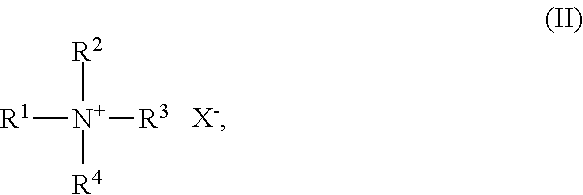Method for inhibiting fading and enhancing color intensity of color-treated hair
a color-treated hair and color-enhancing technology, applied in the direction of hair cosmetics, surface-active detergent compositions, detergent compositions, etc., can solve the problems of color-treated hair being subject to fading, and achieve the effect of increasing the color intensity of color-treated hair
- Summary
- Abstract
- Description
- Claims
- Application Information
AI Technical Summary
Benefits of technology
Problems solved by technology
Method used
Image
Examples
example 1
[0039]This example demonstrates the application of monoalkyl quaternary ammonium salts to afford color fade protection to dyed tresses.
[0040]Small tresses were dyed with either CLAIROL Ultress Burgandy (tress nos. 1-28) or GARNIER 100% Color #660 Intense Auburn (tress nos. 29-33). The dyed tresses were then dipped for 10 minutes into the DI water solutions described in Tables 1-4. The tresses were then blow dried and allowed to stand at room temperature. The tresses were then soaked in DI water overnight and then blown dry the following day. A visual evaluation against a control consisting of a dyed tress soaked in water overnight with no prior dipping was carried out. The results of the experiment are shown in Tables 1-4.
[0041]
TABLE 1Comparative SamplesInventionINGREDIENT23457Hercules Aquacat1%0.8%2%liquid guarClariant SilCare2% 1%1%1%1%Silicone SEAPolyquaternium-100.6%0.2% Cocotrimonium2%Chloride (34%)Visual EvaluationSimilar toSimilar toSimilar toSimilar toRetained noticeablyof C...
example 2
[0047]This example demonstrates the effectiveness of a pre-shampoo treatment in preventing color fade of dyed tresses.
[0048]Tresses (5 gm) were dyed with GARNIER 100% Color #660 Intense Auburn or L'OREAL Dark Burgundy Brown 4BR. The tresses were rinsed for 10 seconds and then soaked in 5 ml of one of the monoalkyl quaternary ammonium salt containing pretreatment solutions (A-E) shown in Table 5, for 1, 5, or 10 minutes. Following pretreatment, the tresses were exposed to shampoo (0.6 ml, 1 min.), 15 second rinse, conditioner (1 ml, 2 min.), 15 second rinse, blow-dry, let stand at room temperature for 1 hour. The tresses were subjected to said treatment 5 times. All rinses were with tap water at 35-40° C. The tresses were assessed visually against a control in which there was no pretreatment with one of the monoalkyl quaternary ammonium pretreatment solutions. Regardless of the dye utilized, tresses that were pretreated with a monoalkyl quaternary ammonium pretreatment solution showe...
PUM
| Property | Measurement | Unit |
|---|---|---|
| color | aaaaa | aaaaa |
| water-soluble | aaaaa | aaaaa |
| pH | aaaaa | aaaaa |
Abstract
Description
Claims
Application Information
 Login to View More
Login to View More - R&D
- Intellectual Property
- Life Sciences
- Materials
- Tech Scout
- Unparalleled Data Quality
- Higher Quality Content
- 60% Fewer Hallucinations
Browse by: Latest US Patents, China's latest patents, Technical Efficacy Thesaurus, Application Domain, Technology Topic, Popular Technical Reports.
© 2025 PatSnap. All rights reserved.Legal|Privacy policy|Modern Slavery Act Transparency Statement|Sitemap|About US| Contact US: help@patsnap.com


